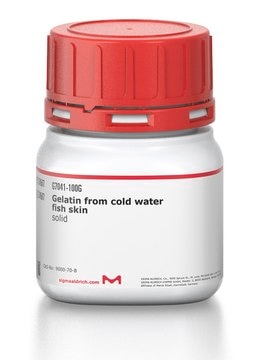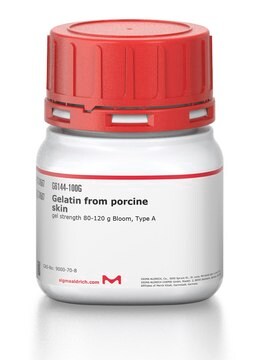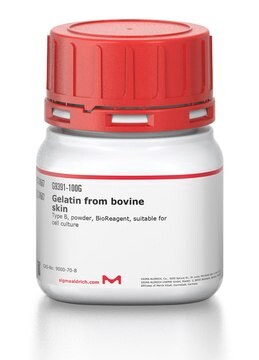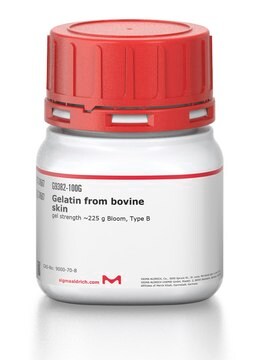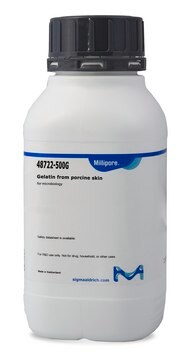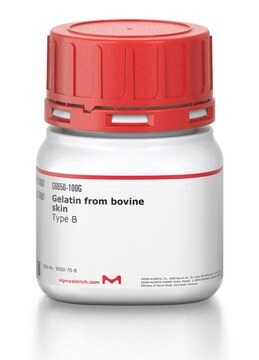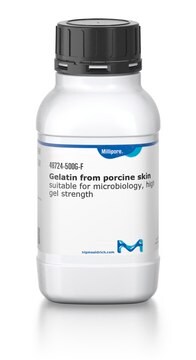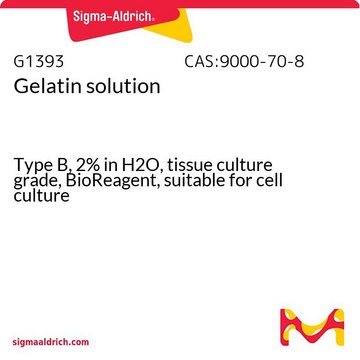G2625
Gelatina from porcine skin
gel strength ~175 g Bloom, Type A
Sinónimos:
Teleostean gelatine
Iniciar sesiónpara Ver la Fijación de precios por contrato y de la organización
About This Item
Productos recomendados
origen biológico
Porcine skin
Nivel de calidad
tpo
Type A
Formulario
powder
concentración
65-85% (biuret)
técnicas
cell culture | mammalian: suitable
solubilidad
H2O: soluble 50 mg/mL
¿Está buscando productos similares? Visita Guía de comparación de productos
Aplicación
This product is recommended for use as a cell culture substratum at 1-5 μg/cm2 or 0.5-50 μg/mL. The optimal concentration does depend on cell type as well as the application and research objectives.
Gelatin has been used in many applications. It has use in coating cell culture to improve attachment of cells, being added to PCR to stabilize Taq DNA, as a blocking reagent in Western blotting, ELISA, and immunochemistry, and as a component of media for species differentiation in bacteriology. As a biocompatible polymer, it has used as a delivery vehicle for release of active biomolecules and in generation of scaffolds for tissue engineering applications. In the pharmaceutical industry, geltan can be used as a suspending and encapsulating agent, among other applications.
Gelatin has been used in many applications. It has use in coating cell culture to improve attachment of cells, being added to PCR to stabilize Taq DNA, as a blocking reagent in Western blotting, ELISA, and immunochemistry, and as a component of media for species differentiation in bacteriology. As a biocompatible polymer, it has used as a delivery vehicle for release of active biomolecules and in generation of scaffolds for tissue engineering applications. In the pharmaceutical industry, geltan can be used as a suspending and encapsulating agent, among other applications.
Componentes
La gelatina es una mezcla heterogénea de proteínas hidrosolubles de elevados pesos moleculares promedio, presentes en el colágeno. Las proteínas se extraen hirviendo en agua la piel, los tendones, los ligamentos, los huesos, etc.. La gelatina de tipo A procede de tejido curado con ácido. La B procede de tejido curado con cal.
Precaución
Dry gelatin, when stored in airtight containers at room temperature, will remain unchanged for many years. When heated at 100°C in the presence of air, it swells becomes soft and disintegrates to a carbonaceous mass with evolution of pyridine bases and ammonia.
Nota de preparación
This product is derived from porcine skin. Gelatin is soluble in hot than in cold water. It is practically insoluble in most organic solvents such as alcohol, chloroform, carbon disulfide, carbon tetrachloride, ether, benzene, acetone, and oils. The Bloom number, determined by the Bloom gelometer, is an indication of the strength of a gel formed from a solution of the known concentration. The Bloom number is proportional to the average molecular mass. Bloom numbers of porcine skin Gelatin vary from 90 to 300 g. This product has a gel strength of 175.
Código de clase de almacenamiento
11 - Combustible Solids
Clase de riesgo para el agua (WGK)
nwg
Punto de inflamabilidad (°F)
Not applicable
Punto de inflamabilidad (°C)
Not applicable
Equipo de protección personal
Eyeshields, Gloves, type N95 (US)
Elija entre una de las versiones más recientes:
¿Ya tiene este producto?
Encuentre la documentación para los productos que ha comprado recientemente en la Biblioteca de documentos.
Los clientes también vieron
Yu-Dong Ma et al.
Environmental toxicology and pharmacology, 48, 63-75 (2016-10-22)
Migration of vascular smooth muscle cells (VSMCs) contributes to intimal hyperplasia and other vascular diseases. Caveolin-1 (Cav-1) has been recognized as a proliferative inhibitor of VSMCs and is likely to be an important regulator of VSMC migration. The underlying mechanism
J W Bulte et al.
Magnetic resonance in medicine, 25(1), 148-157 (1992-05-01)
Human lymphocytes were labeled with biotinylated anti-lymphocyte-directed monoclonal antibodies, to which streptavidin and subsequently biotinylated dextran-magnetite particles were coupled. This labeling resulted in a strong and selective negative contrast enhancement of lymphocyte suspensions at 2.0 T, caused predominantly by the
Jeffrey W Santoso et al.
APL bioengineering, 5(3), 036101-036101 (2021-07-22)
To develop effective cures for neuromuscular diseases, human-relevant in vitro models of neuromuscular tissues are critically needed to probe disease mechanisms on a cellular and molecular level. However, previous attempts to co-culture motor neurons and skeletal muscle have resulted in
Samuel Burke Nanni et al.
Biomarkers in cancer, 8, 77-87 (2016-05-27)
The low-density lipoprotein receptor-related protein 1 (LRP-1) is a multiligand endocytic receptor, which plays a pivotal role in controlling cytoskeleton dynamics during cancer cell migration. Its rapid endocytosis further allows efficient clearance of extracellular ligands. Concanavalin-A (ConA) is a lectin
Felipe Freitas et al.
eLife, 11 (2022-03-15)
Acute kidney injury is common, with ~13 million cases and 1.7 million deaths/year worldwide. A major cause is renal ischaemia, typically following cardiac surgery, renal transplant or severe haemorrhage. We examined the cause of the sustained reduction in renal blood
Artículos
Photo-Crosslinkable Gelatin Hydrogel: Versatile Materials for (High Resolution) Additive Manufacturing
Nuestro equipo de científicos tiene experiencia en todas las áreas de investigación: Ciencias de la vida, Ciencia de los materiales, Síntesis química, Cromatografía, Analítica y muchas otras.
Póngase en contacto con el Servicio técnico

